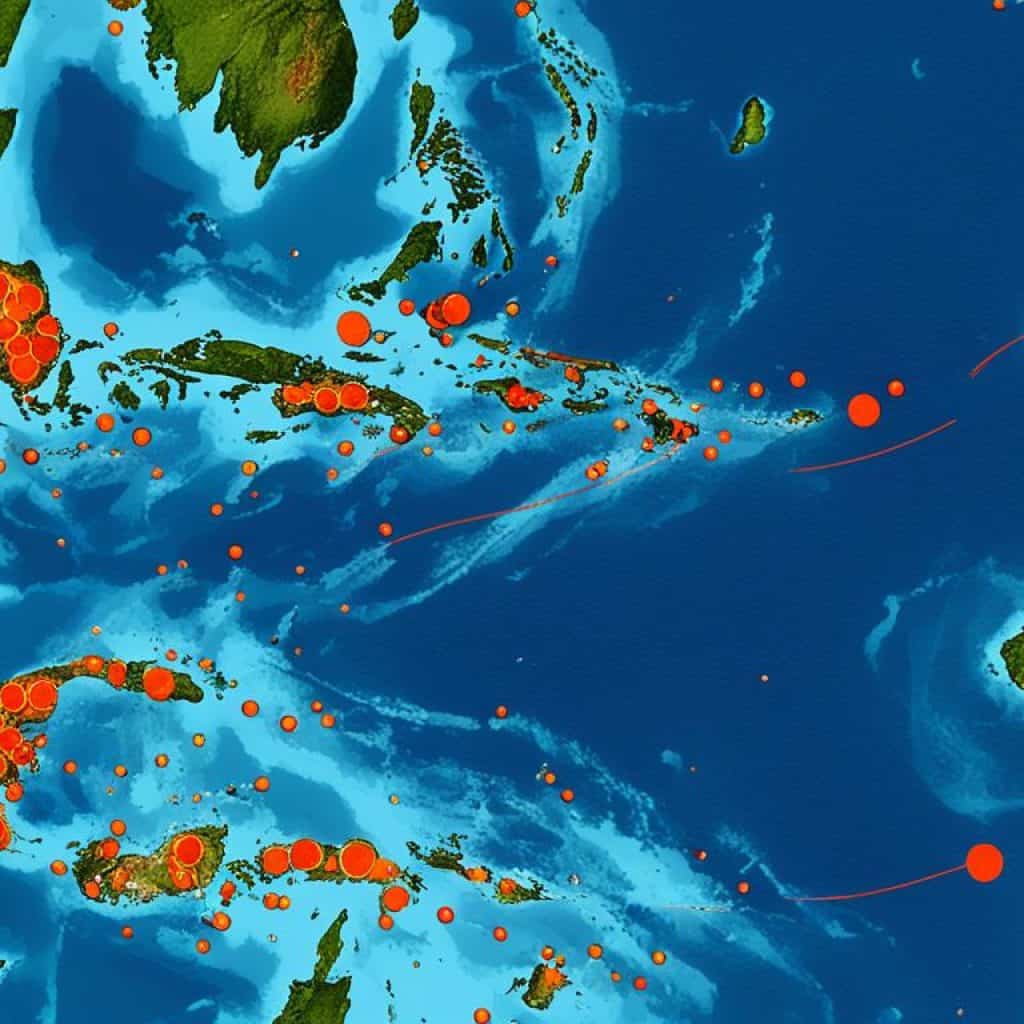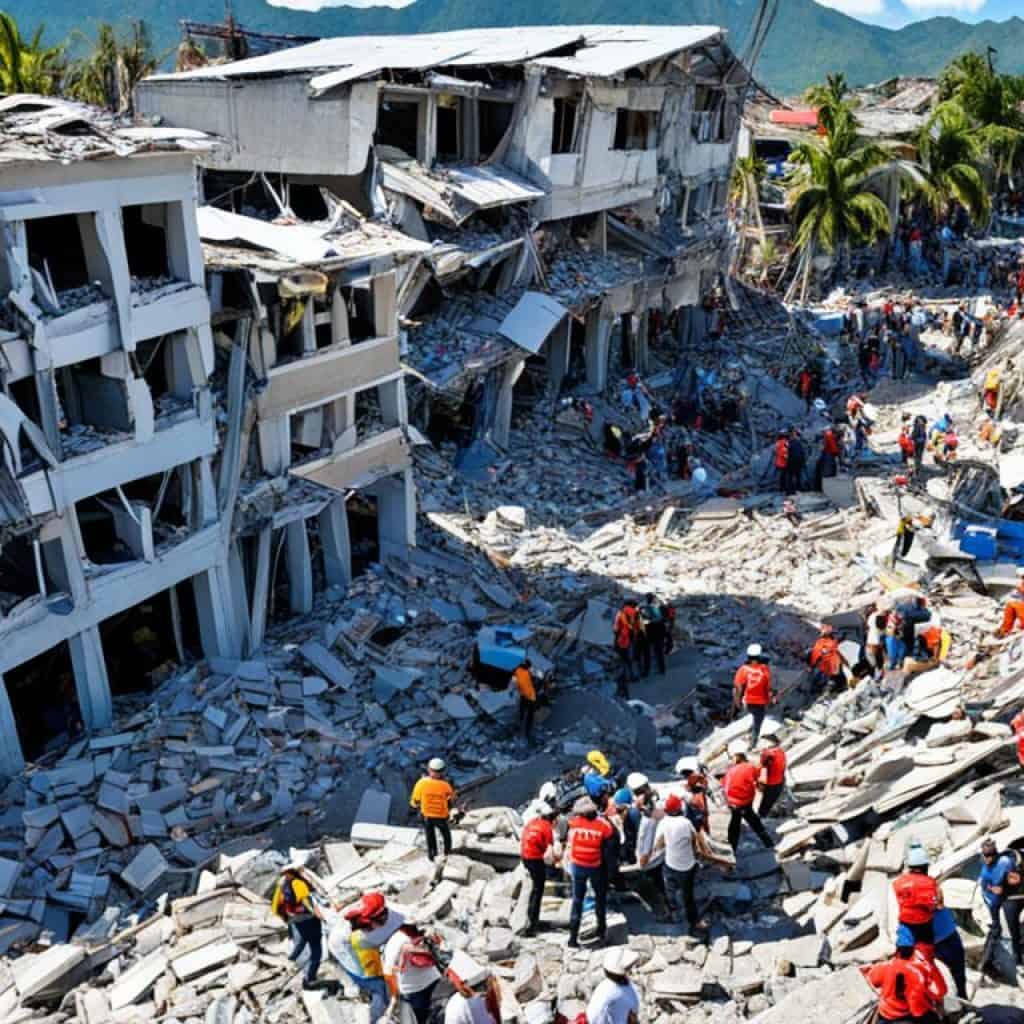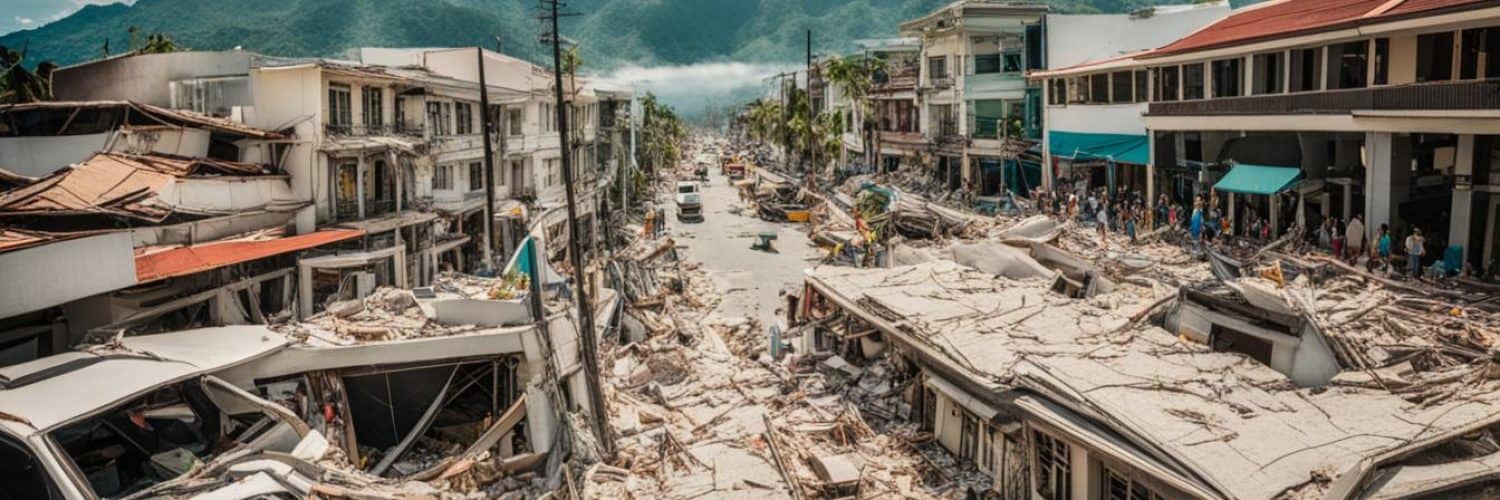When it comes to natural disasters, the Philippines is no stranger. From typhoons to volcanic eruptions, the country has experienced its fair share of challenges. But what about earthquakes? How prepared are we for the unpredictable shaking of the ground beneath our feet?
Recently, the Philippines was hit by a powerful 7.6 magnitude earthquake in the southern region. The impact was felt by thousands of people, and the aftermath left us with many questions. How strong was the earthquake? Were there any casualties? And most importantly, what can we learn from this event to better protect ourselves and our communities in the future?
In this article, we will explore the latest earthquake in the Philippines, delve into the magnitude and impact of the seismic activity, discuss the tsunami warning and safety measures, and examine the ongoing monitoring efforts. We will also take a closer look at the government’s response, explore the impact on local communities, and discuss the lessons learned and the importance of earthquake preparedness.
So join us as we uncover the facts, separate myths from realities, and empower ourselves with the knowledge needed to navigate through the ever-changing landscape of seismic activity. Together, let’s stay informed and ensure the safety and well-being of our beloved Philippines.
Key Takeaways:
- The recent earthquake in the Philippines had a magnitude of 7.6 and affected thousands of people.
- Tsunami warnings were issued, and residents were advised to evacuate to higher ground.
- The Philippine government provided assistance to affected communities.
- Earthquake preparedness and awareness play a crucial role in mitigating the risks associated with seismic activity.
- Staying informed and following safety guidelines are essential for individual and community well-being.
Significant Earthquake: Magnitude and Impact
The recent earthquake that struck the southern Philippines had an estimated magnitude of 7.6, according to the U.S. Geological Survey. This powerful earthquake caused only minor damage to infrastructure in the affected region, highlighting the country’s resilience in the face of seismic activity.
“Despite its high magnitude, the earthquake resulted in minimal damage to buildings and structures.”
While the earthquake’s impact on infrastructure was relatively minor, it is essential to acknowledge the human toll. The earthquake and its aftershocks have sadly resulted in three reported deaths, including a pregnant woman who tragically lost her life while trying to escape her home in Tagum, when a wall collapsed.
To gain a better understanding of the magnitude and impact of this earthquake, let’s take a closer look at the following statistics:
| Earthquake Magnitude | Damage to Infrastructure | Reported Deaths |
|---|---|---|
| 7.6 | Minor | 3 |
The data presented shows that while the earthquake was significant in magnitude, it resulted in minimal damage to the region’s infrastructure. However, the loss of lives is a stark reminder of the importance of preparedness and ensuring the safety of individuals during seismic events.
Next, we will discuss the tsunami warning that was issued following this earthquake and the safety measures taken to protect coastal areas.
Tsunami Warning and Safety Measures
The recent earthquake in the Philippines triggered a tsunami warning for the coastal areas of Davao Oriental and Surigao Del Sur. In this section, we will discuss the safety measures that residents were advised to take and the impact of the tsunami warning.
Evacuation to Higher Ground
Residents in the affected coastal areas were strongly advised to evacuate to higher ground or move farther inland to protect themselves from potential tsunamis. This precautionary measure was taken to ensure their safety and minimize the risk of harm.
Maximum Wave Height and Impact
The Philippine Institute of Volcanology and Seismology recorded tsunamis with a maximum wave height of two feet in certain areas. While this may not seem significant, even small tsunamis can pose danger, especially for those close to the shoreline. It is essential to prioritize safety and follow evacuation advisories to avoid potential harm.
Tsunami Warning Cancellation
After careful assessment and monitoring, the tsunami warning was eventually canceled, and residents were allowed to return to their homes. While the immediate threat had passed, it is important to remain vigilant and stay informed about seismic activity in the Philippines to ensure personal safety.
Below is a visually engaging image illustrating the impact of seismic activity and the need for earthquake preparedness:
The Ring of Fire and Seismic Activity in the Philippines
The Philippines is located along the “Ring of Fire,” a belt of volcanoes encircling the Pacific Ocean that is prone to seismic activity. Earthquakes are common in the country due to its position between two major fault lines. The high levels of seismic and volcanic activity make the Philippines susceptible to earthquakes.

“The Philippines is situated in one of the most seismically active areas in the world. With its location along the Ring of Fire, earthquakes are an inevitable part of life in the country.” – Dr. Maria Carmelita S. Solis, Director of the Philippine Institute of Volcanology and Seismology
Historical Seismic Activity
To understand the extent of seismic activity in the Philippines, it is important to consider the historical record of earthquakes in the region. According to the earthquake tracker in the Philippines, the country experiences an average of 20,000 earthquakes every year, most of which are of low intensity and go unnoticed by the general population.
However, major earthquakes with magnitudes above 6.0 can cause significant damage and affect large areas. The earthquake updates in the Philippines provide crucial information about these seismic events, helping residents and authorities stay informed and take appropriate safety measures.
Earthquake Monitoring and Preparedness
Given the heightened seismic activity, the Philippine Institute of Volcanology and Seismology (PHIVOLCS) plays a crucial role in monitoring earthquakes and providing timely updates. The earthquake tracker Philippines enables PHIVOLCS to assess the magnitude, depth, and location of earthquakes, aiding in their efforts to predict potential aftershocks and mitigate risks.
PHIVOLCS, along with national and local government agencies, continually works on raising public awareness regarding earthquake preparedness. The earthquake updates Philippines not only provide real-time information but also serve as a reminder for individuals and communities to develop comprehensive emergency plans, secure their homes, and understand evacuation procedures in the event of a seismic event.
The Role of Technology in Earthquake Tracking
Advancements in technology have greatly improved earthquake tracking and monitoring capabilities in the Philippines. The earthquake tracker Philippines relies on a network of seismic stations strategically placed across the country to detect and record seismic activity. These stations collect data that helps scientists and seismologists analyze earthquake patterns, identify potential areas of concern, and provide accurate and timely updates to the public.
| Year | Number of Earthquakes | Magnitude |
|---|---|---|
| 2020 | 15,522 | 5.5 – 7.6 |
| 2019 | 19,741 | 4.0 – 7.4 |
| 2018 | 17,825 | 4.2 – 7.1 |
Table: Earthquake statistics in the Philippines from 2018-2020
Understanding the seismic activity in the Philippines is crucial for both residents and authorities. By staying updated with earthquake reports, utilizing the earthquake tracker Philippines, and following safety guidelines, individuals can better prepare for and respond to earthquakes, mitigating the potential risks and ensuring the safety of themselves and their communities.
Previous Earthquake in the Philippines
Prior to the recent earthquake, another significant earthquake occurred in the same region of the Philippines on November 17. This undersea earthquake had a magnitude of 6.8, resulting in widespread damage and loss of life.
According to reports, the earthquake caused 11 deaths and inflicted damage on thousands of houses and infrastructure sites. Over 20,000 families were affected, and certain areas experienced power outages as a result of the tremors.
The Impact of the Previous Earthquake
The previous earthquake left a lasting impact on communities in the affected region. It disrupted the daily lives of thousands of individuals and families, leading to significant challenges in terms of housing, infrastructure, and basic services.
Local authorities and organizations worked tirelessly to provide support and assistance to those affected. Relief efforts were focused on restoring infrastructure, providing temporary shelter, and ensuring the well-being of the impacted communities.
Learning from Past Events
Every earthquake event serves as a learning opportunity for communities to enhance their preparedness and response measures. The previous earthquake highlighted the importance of earthquake-resistant infrastructure, effective early warning systems, and comprehensive disaster management plans.
By studying the impacts of previous earthquakes, we can improve our understanding of seismic risks and implement measures to protect lives and minimize property damage in the future. It is crucial to remain vigilant and ensure that our communities are well-prepared for any future seismic events.
Investing in research, monitoring systems, and public education can help communities build resilience and respond effectively to earthquakes. Continued efforts in these areas will contribute to a safer and more secure future for the Philippines.
Impact on Local Communities
The recent earthquake in the Philippines had a significant impact on various local communities, particularly in the southern region. One area that experienced severe consequences was Hinatuan, where nearly 48,000 people were affected by the earthquake and its subsequent aftershocks.
As a result of the earthquake, several residents were forced to evacuate their homes, seeking safety and shelter in large industrial buildings. The devastation caused damage to critical infrastructure and led to the collapse of numerous homes in different areas.
Communities affected by the earthquake are now faced with the challenging task of rebuilding and recovering from the disaster. The destruction of homes and infrastructure poses significant obstacles in the path to recovery, necessitating support from local authorities and relief organizations.
“Our hearts go out to the affected communities as they unite to overcome this tragedy. Together, we can rebuild and create a stronger and safer future for all.”
Government Response and Assistance
The Philippine government has swiftly responded to the recent earthquake in the Philippines, providing vital assistance and support to affected communities. Recognizing the urgent needs of earthquake victims, the government has taken several measures to alleviate suffering and aid in the recovery process.
Financial aid has been extended to families who have lost loved ones or incurred injuries during the earthquake. This assistance aims to alleviate the financial burden faced by affected families and help them rebuild their lives.
Additionally, the government has taken responsibility for covering the hospital bills of those injured in the earthquake. This initiative ensures that necessary medical treatment is accessible to all, without further burdening individuals and families already grappling with the aftermath of the disaster.
In order to ensure the safety and well-being of students, local government areas have temporarily canceled school. This precautionary measure allows authorities to assess the structural integrity of public facilities and guarantee the safety of students and staff when classes resume.
The Philippine government continues to closely monitor the situation and provide necessary support to affected communities. Efforts are being made to assess the extent of the damage and determine the most effective ways to aid in the recovery and rebuilding process. Through collaboration with various government agencies and local authorities, the government aims to ensure that the affected areas receive the assistance they need in a timely and efficient manner.

The government’s response and assistance in the wake of this earthquake demonstrate its commitment to the well-being of its citizens and its determination to alleviate suffering and support affected communities. By providing financial aid, covering medical expenses, and prioritizing safety, the government is working towards the recovery and rebuilding of the affected areas in the Philippines.
Seismic Energy Released and Activity Level
The recent earthquake in the Philippines resulted in the release of a significant amount of seismic energy. According to estimates by the U.S. Geological Survey, the combined energy released during the earthquake was approximately 5.6 x 10^11 joules. To put it into perspective, this amount of energy is equivalent to:
- 157 megawatt hours, which is enough energy to power approximately:
- 15,700 homes for an hour
- 5,900 homes for four hours
- 270,000 pounds of dynamites
- 122,400 kilograms of explosives
This level of seismic energy release indicates the strength and intensity of the earthquake. It is an important factor in understanding the potential impact and assessing the overall seismic activity in the region.
Seismic Activity Assessment
The seismic activity level resulting from the recent earthquake is currently being assessed by experts. This assessment involves comparing the recorded seismic data with the average activity level in the area. By analyzing the data, scientists can determine if there has been a significant increase or decrease in seismic activity. This assessment is vital for understanding the overall seismic stability of the region and identifying potential risks for future earthquakes.
| Seismic Energy Released | Equivalent Energy |
|---|---|
| 5.6 x 10^11 joules | 157 megawatt hours |
| 135 tons of TNT |
Aftershocks and Continued Monitoring
Following the initial earthquake in the Philippines, numerous aftershocks have occurred, including a 6.6 magnitude quake. The seismic activity in the country has been closely monitored by the Philippine Institute of Volcanology and Seismology (PHIVOLCS). Since the earthquake, more than a thousand seismic events have been recorded by PHIVOLCS.
The aftershocks serve as a constant reminder of the ongoing seismic activity in the Philippines. Seismic stations and monitoring systems have been activated to track and assess these aftershocks in real-time. This continuous monitoring allows for the timely dissemination of updates to the public, ensuring their safety and well-being.
By closely monitoring the seismic activity, experts can analyze patterns and trends to gain a better understanding of earthquake behavior in the region.
Seismic Activity Statistics:
To provide a comprehensive overview, the table below showcases key seismic activity statistics since the recent earthquake.
| Date | Magnitude | Location |
|---|---|---|
| December 2, 2021 | 7.6 | Near Surigao del Sur |
| December 3, 2021 | 6.6 | Near Surigao del Sur |
| December 4, 2021 | 6.3 | Near Surigao del Sur |
These statistics demonstrate that seismic activity in the Philippines remains active, reinforcing the importance of continued monitoring and preparedness.
Stay informed about earthquake updates in the Philippines and be aware of the seismic activity unfolding in the region. By staying vigilant and following the guidance provided by local authorities, individuals can prioritize their safety and the safety of their communities.
Impact on Hospitals and Medical Facilities
The recent earthquake in the Philippines had a significant impact on hospitals and medical facilities in the affected areas. One such incident took place in Butuan City, where a strong tremor prompted the evacuation of a hospital to ensure the safety of patients and medical staff.

The medical professionals at the evacuated hospital exhibited remarkable resilience and dedication as they promptly provided first aid and medical attention to those in need. Their quick response played a crucial role in ensuring the well-being of the affected individuals.
Furthermore, power outages caused by the earthquake had a direct impact on hospitals and medical facilities in certain areas. The loss of electricity posed challenges for healthcare providers in delivering essential medical services, particularly in situations requiring specialized equipment and life-saving treatments.
“The earthquake reminded us of the importance of emergency preparedness, especially in healthcare facilities. It is crucial for hospitals and medical centers to have backup power sources and contingency plans in place to ensure uninterrupted patient care during natural disasters.”
The government, alongside local organizations, is actively working to address the needs of the healthcare sector and provide necessary support. Measures are being taken to restore power supply to affected areas, ensuring that hospitals and medical facilities can resume their crucial operations swiftly.
It is important to recognize and appreciate the resilience and dedication of healthcare professionals who continue to serve and care for those affected by the earthquake, even in challenging circumstances.
| Hospitals and Medical Facilities | Impact |
|---|---|
| Evacuated hospital in Butuan City | Ensured safety and provided immediate medical assistance to patients |
| Hospitals in areas with power outages | Challenges in delivering medical services due to lack of electricity |
| Government and local organizations | Working to address healthcare sector needs and provide support |
Lessons Learned and Preparedness
The recent earthquake in the Philippines serves as a powerful reminder of the importance of earthquake preparedness and awareness. As a resident in an earthquake-prone area, it is crucial to familiarize yourself with safety protocols and take necessary precautions to protect yourself and your loved ones.
During an earthquake, finding sturdy shelter is vital to reduce the risk of injury. Identify safe spaces in your home or workplace, such as under a sturdy table or desk, and practice taking cover in these areas. Remember to protect your head and neck during an earthquake.
In the event of a tsunami warning, it is crucial to follow evacuation advisories and move to higher ground or farther inland. Tsunamis can pose significant dangers to coastal areas, and timely evacuation can save lives. Stay informed about the latest updates and instructions from local authorities and emergency services.
Here are some earthquake safety tips:
- Secure heavy furniture and objects to prevent them from toppling over during an earthquake.
- Create an emergency kit with essential supplies, including non-perishable food, water, flashlights, batteries, a first aid kit, and any necessary medications.
- Establish a communication plan with your family or household members to ensure that everyone knows how to contact each other in an emergency.
- Regularly practice earthquake drills to reinforce safe behaviors and responses.
- Stay updated on seismic activity in the Philippines by following earthquake updates from reliable sources and utilizing earthquake trackers.
Remember, preparedness is key to minimize the impact of natural disasters. By staying informed, taking necessary precautions, and practicing safety protocols, you can help protect yourself, your family, and your community from the devastating effects of earthquakes.
| Earthquake Safety Tips |
|---|
| Secure heavy furniture and objects |
| Create an emergency kit |
| Establish a communication plan |
| Practice earthquake drills |
| Stay updated on seismic activity |
Media Coverage and Public Awareness
The recent earthquakes in the Philippines have garnered significant media coverage both locally and internationally. News outlets and government agencies have been actively providing updates and warnings to keep the public informed about the latest earthquake news in the Philippines and the ongoing earthquake updates in the region.
This widespread coverage has played a crucial role in raising public awareness about the potential dangers associated with earthquakes, as well as the importance of staying informed and prepared. The media coverage has helped disseminate vital information, such as earthquake safety tips, seismic activity updates, and emergency evacuation procedures to the public.
The recent earthquake in the Philippines serves as a reminder that earthquake-prone regions must remain informed and prepared. By staying updated with the latest earthquake news in the Philippines and actively following earthquake updates, individuals can take necessary precautions to protect themselves and their communities.
Through media channels, reports on recent earthquakes in the Philippines have highlighted the need for earthquake preparedness and emphasized the importance of having an emergency plan in place. This increased public awareness has prompted individuals to take proactive steps towards ensuring their safety and the safety of their loved ones during seismic events.
Furthermore, the media coverage has shed light on the efforts made by government organizations and local communities to respond to earthquakes effectively. The public’s understanding of the resources available and the response measures implemented in the aftermath of earthquakes has been significantly enhanced. This knowledge contributes to a greater sense of security and preparedness among the population.
The media coverage surrounding recent earthquakes in the Philippines has not only served as a source of information but has also played an instrumental role in increasing public awareness, encouraging individuals to prioritize earthquake safety and preparedness.
Staying Informed - A Key Step
To stay updated on earthquakes in the Philippines, it is recommended to follow reputable news sources, local government agencies, and seismic monitoring organizations. By actively seeking out earthquake reports and staying informed about seismic activities through official channels, individuals can make informed decisions and take timely actions to mitigate risks during earthquakes.
Conclusion
The recent earthquake in the Philippines serves as a stark reminder of the country’s vulnerability to seismic activity. Located within the Ring of Fire, the Philippines experiences frequent earthquakes, putting local communities at risk. The government’s response and the impact on affected areas emphasize the crucial need for continuous monitoring, preparedness, and support.
Staying informed about the latest earthquake reports and statistics in the Philippines is vital for individuals to understand the risks and take necessary precautions. By following safety guidelines, such as finding sturdy shelter during earthquakes and heeding evacuation advisories during tsunami warnings, individuals can significantly reduce the impact on themselves and their communities.
The earthquake statistics and reports reinforce the importance of ongoing monitoring. Seismic activity in the Philippines is continuously tracked to provide real-time updates and ensure public safety. Through these efforts and the collective preparedness of the community, the risks associated with earthquakes can be mitigated.
As the Philippines recovers from the latest earthquake, it is crucial to recognize the value of preparedness and support for affected areas. By raising public awareness and providing the necessary resources and assistance, the government and various organizations can help communities rebuild and ensure their resilience against future natural disasters.
FAQ
What was the magnitude of the recent earthquake in the Philippines?
The recent earthquake in the Philippines had a magnitude of 7.6.
Where did the earthquake occur in the Philippines?
The earthquake occurred near the province of Surigao del Sur in Mindanao.
How many aftershocks were there?
There were several aftershocks, with magnitudes ranging from 6.8 to 6.5.
How many people were affected by the earthquake?
Nearly 48,000 people were affected by the earthquake and its aftershocks.
Was there a tsunami warning?
Yes, there was a tsunami warning for the coastal areas of Davao Oriental and Surigao Del Sur.
Were there any reported deaths?
Yes, three deaths were reported, including a pregnant woman.
How did the government respond to the earthquake?
The government provided financial aid to families of earthquake victims and covered hospital bills for the injured.
How can individuals prepare for earthquakes?
Individuals can familiarize themselves with safety protocols and follow evacuation advisories in the event of a tsunami warning.
Has there been any increase or decrease in seismic activity?
The seismic activity level is currently being assessed to determine any significant changes.
Is there ongoing monitoring of aftershocks?
Yes, seismic stations and monitoring systems are tracking and assessing the aftershocks in real-time.
How did the earthquake impact hospitals and medical facilities?
The earthquake caused power outages in certain areas, affecting hospitals and medical facilities.
What lessons can be learned from this earthquake?
This earthquake serves as a reminder of the importance of earthquake preparedness and awareness.


















Add comment